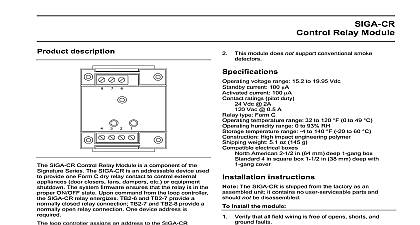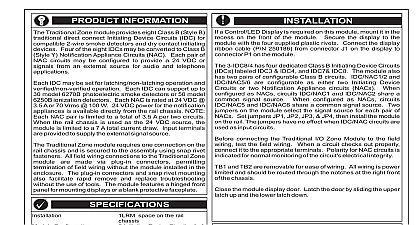EST FIRESHIELD TECH REF MANUAL

File Preview
Click below to download for free
Click below to download for free
File Data
| Name | est-fireshield-tech-ref-manual-0915326748.pdf |
|---|---|
| Type | |
| Size | 2.20 MB |
| Downloads |
Text Preview
Reference Manual 3100353 Rev 3.0 12MAY03 BY 941 739 4200 2002 INFORMATION of liability product has been designed to meet the requirements of standards listed in statement below in accordance with this manual applicable and the instructions of the Authority Having is mandatory The manufacturer shall not under circumstances be liable for any incidental or damages arising from loss of property or other or losses owing to the failure of products beyond cost of repair or replacement of any defective products manufacturer reserves the right to make product and change product specifications at any every precaution has been taken during the of this manual to ensure the accuracy of its the manufacturer assumes no responsibility for or omissions warning equipment can generate and radiate radio frequency If this equipment is not installed in accordance with manual it may cause interference to radio This equipment has been tested and found comply within the limits for Class A digital devices to Subpart B of Part 15 of the FCC Rules These are designed to provide reasonable protection against interference when this equipment is operated in a environment Operation of this equipment is to cause interference in which case the user at his expense will be required to take whatever measures be required to correct the interference statement when properly installed operates as a Local Premises Fire Alarm System in accordance with following standards Standard 72 1999 Edition 70 National Electrical Code Laboratories Standard 864 8th Edition Laboratories of Canada Standard ULC Electrical Code Part I for Installation of Fire Alarm Systems S524 for the Inspection and Testing of Fire Alarm ULC S536 also complies with Local Protective Signaling L manual M automatic A waterflow WF and supervisory SS for C and non coded signaling NC Station type RS with RPM or FSDACT type A with CTM4.7 this may include Local Shunt type connection to Master Box type LS Station Type CS with FSDACT 1 2 overview and operation 1.1 overview 1.1 overview 1.1 and indicators 1.1 descriptions 1.3 the panel 1.4 LCD messages 1.7 2.1 checklist 2.1 the cabinet 2.1 the Remote System Indicator 2.2 the Remote Zone Indicator 2.3 the Remote Relay Module 2.5 the Power Expander Transformer 2.7 the FSDACT 2.8 an RPM module 2.10 a CTM module 2.11 an auxiliary power supply 2.12 the terminal shield 2.12 3 3.1 3.1 the factory default settings 3.2 an FSDACT 3.2 programming the panel 3.2 programming 3.8 4 4.1 maintenance 4.1 A A 1 calculation worksheet A 1 appliance voltage drop A 3 appliance circuit maximum wire calculation A 4 B templates B 1 programming worksheet B 1 programming worksheet B 2 C settings and wiring diagrams C 1 D specifications D 1 E event codes E 1 Contact ID event codes E 1 4 2 event codes E 2 Z 1 Fire Alarm Control Panel Operating 1 1 overview and operation overview is available in three models three zone five zone ten zone Each model is similar except for the number of device circuits IDCs and notification appliance NACs as shown in the following table three zone five zone ten zone numbers may have the following suffixes G or R gray or red enclosure GD or RD indicates panel with GC indicates ULC panel with terminal shield GF a French ULC panel with terminal shield and G 2 230 Vac input panel is configured for Class B operation All models for the three zone can be easily converted to Class A using two Class B circuits to make one Class A circuit has the following optional components System Indicator FSRSI Zone Indicator FSRZI A Relay Module FSRRM Expander Transformer XTR3A120 XTR3A230 only Dialer Modem FSDACT Tie Module CTM4.7 Polarity Module RPM Cabinet BC 2 to Chapter 2 for optional module details overview panel operates in normal mode in the absence of any supervisory trouble or monitor events In normal the control panel monitors the system panel operates in off normal mode any time an event is into the system When this happens the panel contact positions on appropriate common relays alarm outputs for alarm events only on the appropriate LEDs and the panel buzzer the appropriate programmed output response for input that signaled the event event information to appropriate optional FSRSI FSRZI A CTM4.7 or RPM the optional FSDACT is installed the panel a record of the event to the FSDACT LCD and to history log the FSDACT to transmit event messages to a station as programmed and indicators DRILL 1 2 panel display Lamp test Control buttons the Remote Disconnect and Walk Test simultaneously to initiate a panel test This lets you verify proper of the LEDs on the panel and the annunciators mode with FSDACT Disables or FSDACT Has no effect on alarm mode without FSDACT Disables enables the common alarm relay mode Selects the next option mode Places the panel in walk mode The Walk Test LED is on when panel is in walk test mode mode Selects the previous Technical Reference Manual overview and operation DRILL LED LED mode Initiates a panel reset mode Selects the next for the current option mode Silences active notification Pressing Signal Silence a time turns NACs back on The Signal LED indicates when the panel is in and operating with notification turned off Visual appliances may may not turn off when Signal Silence is depending on panel programming mode Activates the drill function notification appliances on according to panel programming but does not place panel in alarm or activate the alarm Pressing Drill a second time turns off drill function mode Selects the previous of the current program option mode Silences the panel and sounders during an active trouble or alarm event mode Saves the program steady when an alarm input device is steady when there is a wiring fault on the Double flashes when the circuit is Fast flashes during walk test the IDC is resetting steady when a supervisory input device

